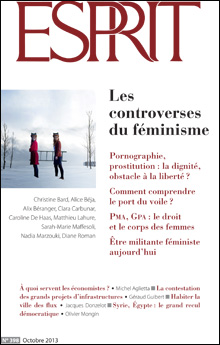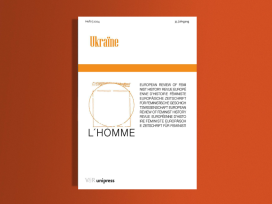Esprit does not have a specific policy on gender concerning the hiring of staff. This is partly due to the fact that we are a very small organization (four employees) and that the staff turnover is therefore very small (three of the four employees have been working at Esprit for twenty years or more).
As far as the division of labour is concerned: the publication’s director and editor in chief are both male, the assistant editor and administrative director are female.
In addition to the two female and two male full-time employees working at Esprit in 2012, we also had four interns (three male, one female).
The relation between gender and wages is neutral. The latest addition to the team (the assistant editor) took place in 2011, and the decision regarding wages was made independently of the gender of the applicants. The assistant editor is female, thus changing the ratio (currently 50/50). Since Esprit does not plan on recruiting any staff members in the short term, we cannot foresee any changes in this regard.
 There is no strict gender policy in the commissioning of articles. However, we do try to commission female authors as often as possible. In certain areas, it can be more difficult than in others to find female contributors. We always privilege the topic that we are interested in and the quality of the authors we commission the articles to; we are also constrained by the composition of the existing networks within which we work. But we try as much as possible, given the limited time and resources we have at our disposal, to diversify our “pool” of authors; this concerns gender, but also other categories (younger authors, for instance).
There is no strict gender policy in the commissioning of articles. However, we do try to commission female authors as often as possible. In certain areas, it can be more difficult than in others to find female contributors. We always privilege the topic that we are interested in and the quality of the authors we commission the articles to; we are also constrained by the composition of the existing networks within which we work. But we try as much as possible, given the limited time and resources we have at our disposal, to diversify our “pool” of authors; this concerns gender, but also other categories (younger authors, for instance).
In 2012, we published 218 male authors and 81 female authors. The number of female authors has increased during my term as editor, and I expect it to rise in the future. The gender policy of the editorial board will play a role here, since it has repercussions on the authors we commission (some being members of the editorial board, others being recommended to us by members of the editorial board). From January 2013 onwards, all new nominations to the editorial board have been gender neutral (one female member for each male member).
Gender and cultural journals
Eurozine partner journals are not unique in being dominated by male editors and contributors. But what’s the bigger picture regarding gender and cultural journals? Do journals have the resources to deal with it? And what role does gender play, if any, where commissioning patterns and content are concerned?
Eurozine asked selected partner journals to respond to a European survey on gender and cultural journals that examines these issues in greater depth.
Dialogi, Slovenia
Soundings, UK
Syn og Segn, Norway
Esprit, France
Merkur, Germany
Gernero, Serbia
ResPublica Nova, Poland
Spilne, Ukraine
L’Homme, Austria
As for data on gender concerning the board of administration, it consists of four males and one female. No data can be provided as to “owners”, since we have a lot of small shareholders, and do not have figures regarding them. The editorial board consists of 43 male and 11 female members; the advisory board of four male members and one female member.
There are no employment quotas, nor any attempts to influence the content of the journal based on gender issues. The funding that we receive is not dependent on gender issues. Historically, gender has not been featured as a major issue in our journal. Our October 2013 issue was however devoted to current debates on feminism. On this topic, most authors are female, most researchers working on gender issues being female. It is not necessarily a question of being better equipped, and the issue of “who speaks for whom” is one we raise in our issue, but of being more interested in the topic of gender because women have, by definition, and so long as equality is not attained, a stronger awareness of these problems.
Gender issues can always benefit from female/male dialogue, but one must not underestimate the divergences that exist between female authors and researchers, and between feminist activists, an aspect that we will also focus on.
Topics and areas of expertise are of course gendered: issues that deal with culture, for instance, will tend to be more feminized. The gendered nature of some topics is related to a wider question of education and socialization of women. It is to be hoped that such divisions will decrease in the future. We can encourage this shift by calling on women to write on economics, on geopolitics, but as producers of cultural journals, we come, one might say, at the “end” of the process of education and socialization. These issues have to be tackled in school, in the way that parents talk to their children about such matters, etc… As a cultural journal our role is to analyse the evolution in education and socialization.
We do not have extensive data on our audience, but we did a compilation of the information voluntarily given to us by those who register on our website (who are not necessarily subscribers to the journal – they simply register to buy an article or an issue or to receive our newsletter). In 2012, for instance, 11,312 people were registered on our website. Of those, 4705 did not mention their gender. 5124 were male (45 per cent) and 4007 (35 per cent) female.
The field of cultural journals, at least in France, is very precarious and operated by very small organizations for whom it is difficult to implement quotas. However, they should be encouraged to promote women. Rather than a strict quota on employment, one could think of public subsidies that would, for instance, be conditioned on the participation of women to a given issue or series of issues.
Although we believe there is no reason for cultural journals to think of themselves as not needing to take into account gender or other categories in their day to day work, we also think that procedures should be adapted to their size and mode of functioning. A top-down approach, that would impose very strict rules and controls could put a strain on fragile structures that possess limited resources to implement them. However, there is definitely a need for a change in mentalities, which can be attained through indirect procedures of promotion for women, through a stricter policy concerning editorial and advisory boards, and through a heightened awareness of gender issues.

 There is no strict gender policy in the commissioning of articles. However, we do try to commission female authors as often as possible. In certain areas, it can be more difficult than in others to find female contributors. We always privilege the topic that we are interested in and the quality of the authors we commission the articles to; we are also constrained by the composition of the existing networks within which we work. But we try as much as possible, given the limited time and resources we have at our disposal, to diversify our “pool” of authors; this concerns gender, but also other categories (younger authors, for instance).
There is no strict gender policy in the commissioning of articles. However, we do try to commission female authors as often as possible. In certain areas, it can be more difficult than in others to find female contributors. We always privilege the topic that we are interested in and the quality of the authors we commission the articles to; we are also constrained by the composition of the existing networks within which we work. But we try as much as possible, given the limited time and resources we have at our disposal, to diversify our “pool” of authors; this concerns gender, but also other categories (younger authors, for instance).




